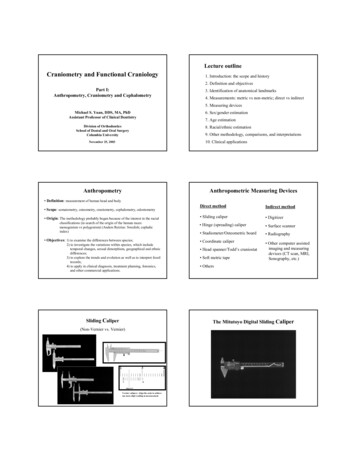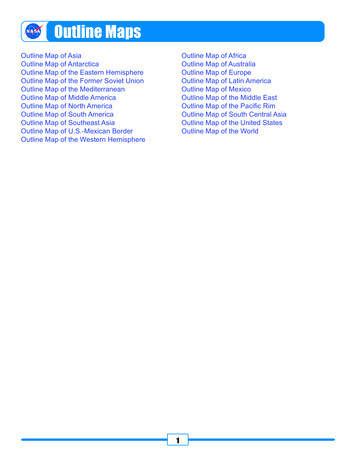
Transcription
Lecture outlineCraniometry and Functional Craniology1. Introduction: the scope and history2. Definition and objectivesPart I:Anthropometry, Craniometry and Cephalometry3. Identification of anatomical landmarks4. Measurements: metric vs non-metric; direct vs indirect5. Measuring devicesMichael S. Yuan, DDS, MA, PhDAssistant Professor of Clinical DentistryDivision of OrthodonticsSchool of Dental and Oral SurgeryColumbia University6. Sex/gender estimation7. Age estimation8. Racial/ethnic estimation9. Other methodology, comparisons, and interpretations10. Clinical applicationsNovember 25, 2003AnthropometryAnthropometric Measuring Devices Definition: measurement of human head and body Scope: somatometry, osteometry, craniometry, cephalometry, odontometry Origin: The methodology probably began because of the interest in the racialclassifications (in search of the origin of the human races:monogenism vs polygenism) (Anders Retzius: Swedish; cephalicindex) Objectives: 1) to examine the differences between species;2) to investigate the variations within species, which includetemporal changes, sexual dimorphism, geographical and ethnicdifferences;3) to explore the trends and evolution as well as to interpret fossilrecords;4) to apply in clinical diagnosis, treatment planning, forensics,and other commercial applications.Sliding CaliperDirect methodIndirect method Sliding caliper Digitizer Hinge (spreading) caliper Surface scanner Stadiometer/Osteometric board Radiography Coordinate caliper Other computer assistedimaging and measuringdevices (CT scan, MRI,Sonography, etc.) Head spanner/Todd’s craniostat Soft metric tape OthersThe Mitutoyo Digital Sliding Caliper(Non-Vernier vs. Vernier)closedopenVernier calipers: Align the scale to achieveone more digit reading in measurement1
StadiometerSpreading CaliperclosedOsteometric BoardSoft Metric Tape“Stretch of the Measuring”Johann Wolfgang von Goethe, 1779openTodd’Todd’s Craniostat(Head Spanner)Body Imaging: 3-DSurface AnthropometryThe Loughborough Anthropometric Shadow Scanner2
The computerized whole- body image after scanning(Surface area and volume estimations; Shape capturing and reconstruction)3-DImaging(morphometrics in size and shape)Source: Pre-operative (L) and post-operative (R) 3-D images of a trigonocephaly raniofacial.html (2002)CraniometryThe Traditional Landmarks of the Skull Definition: measurement of human dry skullMid-Sagittal Landmarks: 1) true vs relative landmarks2) mid-sagittal vs bilateral landmarks Measurements: 1) qualitative (non-metric) vsquantitative (metric)2) metric: angular, arc, linear, volumetricproportional Cranial and facial indices Cranial and facial formsThe Traditional Landmarks of the SkullBilateralAcanthionAlveolareAlveolonApexANS (Anterior nasal onOpisthionOpisthocranionOralePogonionPNS (Anterior nasal e (A)SupradentaleSupramentale (B)SymphysionVertexBasion: the midpoint of the anterior margin of the foramen magnum.Bregma: the intersection of the coronal and sagittal sutures in the midline.Glabella: the most forward projecting point in the midline of the forehead at the level of the supra-orbitalridges and above the nasofrontal suture.Euryon: the two points on the opposite sides of the skull that form termini of the lines of greatest breadth.The two points are determined instrumentally.Gnathion: the most anterior and lowest median point on the border of the leGonion: the midpoint of the angel of the mandible between body and ramus.Lambda: the intersection of the sagittal and lambdoidal sutures in the midline.Mastoidale: the lowest point of the mastoid processMenton: the lowest median point of the chin.Nasion: the intersection of the nasofrontal suture with the midsagittal plane. Nasion is theuppermost landmark for the measure of facial height.Opisthocranion: the most posterior point on the skull not on the external occipital protuberance. It is theposterior end point of maximum cranial length measured from glabella. It is determinedinstrumentally.Orbitale: the lowest point in the margin of the orbit; one of the points used in defining FrankfortHorizontal.Pogonion: the most anterior point in the midline of the chin.Porion: the uppermost lateral point in the margin of the external auditory meatus. The right and leftporion with the left orbitale define the Frankfort HorizontalZygion: the most lateral point of the zygomatic arch. It is determined instrumentally.3
Frankfort Horizontal (FH)1) A plane passing through three points of the right and left porion and the left orbitale.2) First proposed at the Craniometric Congress held in Munich, Germany, 1877.3) An orientation of skull in a consistent and reproducible position.4) Comparisons: natural head position; horizontal visual axis; and horizontal plane.Skull: Frontal ViewDrawing of a Child at Birth, Age 1, Age 2Bergmüller (1723), Countway Library, BostonSkull: Lateral ViewSkull: Basal ViewCraniometric Measurements (I)Cranial circumferenceMax. cranial breadthMin. frontal breadthBigonial breadthUpper facial heightBasion-Prosthion lengthNasal breadth (max.)Lower nasal breadthOrbital breadthBiorbital breadthForamen magnum breadthCranial heightMax. cranial lengthBizygomatic breadthTotal facial heightBasion-Nasion lengthBasal heightUpper nasal breadthOrbital heightInterorbital breadthPalate-external breadth & lengthPalate-internal breadth & length4
Craniometric Measurements (II)Condylo-symphyseal lengthBicondylar widthMin. ramus breadthMandibular body heightSymphyseal heightMastoid lengthAscending ramus heightMandibular body breadthMandibular body lengthSkull: Frontal MeasurementsTotal facial angleMid-facial angleAlveolar angleNasion-Opisthion arcTransverse arcSagittal cordCoronal cordSkull: Lateral MeasurementsCranial and Facial IndicesCranial indexCranial length- height indexCranial breadth- height indexTotal facial indexUpper facial indexNasal indexOrbital indexExternal palatal indexSkull: Palatal MeasurementsOrbital IndexOrbital height x 100Orbital Index --------------------------Orbital breadthOrbital ht.Orbital br.Chamaeconchy (X-82.99): wide orbitsMesoconchy (83.00-89.99): average or mediumHypsioconchy (89.00-X): narrow or square orbits5
Nasal IndexCranial IndexNasal breadth x 100Nasal Index ------------------------------Nasal heightLeptorrhiny (X-47.99): narrow nasal apertureMesorrhiny (48.00-52.99): average or mediumPlatyrrhiny (53.00-X): broad or wide nasal apertureCephalic IndexMax. cephalic breadth x 100Cephalic Index ------------------------------------Max. cephalic lengthDolichocephaly (X-74.99): narrow or long headedMesocephaly (75.00-79.99): average or mediumBrachycephaly (80.00-84.99): broad or round headedHyperbrachycephaly (85.00-X): very broad headedDinaric(Dry Skull)Max. cranial breadth x 100Cranial Index ------------------------------------Max. cranial lengthDolichocrany (X-74.99): narrow or long calvariumMesocrany (75.00-79.99): average or medium calvariumBrachycrany (80.00-84.99): broad or round calvariumHyperbrachycrany (85.00-X): very broad headed calvariumFacial IndexTotal facial height x 100Facial Index --------------------------------------Bizygomatic breadthHypereuryprosopy (X-79.99): very broad faceEuryprosopy (80.00-84.99): broad faceMesoprosopy (85.00-89.99): average or mediumLeptoprosopy (90.00-94.99): slender or narrow faceHyperleptoprosopy (95.00-X): very slender or narrow faceSource: Drs. Bryan Scott & Sonia AbrahamSex/Gender Differences in the SkullSex/Gender Estimation6
Skull: InfantSexing the Skull(Multiple Regression Analysis)Caucasian samples1.236 (Glabella.Opisthocranion) – 1.0 (Euryon.Euryon) 3.291 (Zygion.Zygion) 1.528 (Porion.Mastoidale) [563.93] (mm)Score 563.97: MaleScore 563.97: Female85.5% confidence of accuracySource: modified from Giles (1970)Racial/Ethnic DifferencesTemporal Changes(Infant vs Adult)proportion comparisonsize comparisonDifferences btw Species: Lateral viewCaucasoidMongoloidNegroidDifferences btw Species: Cranial viewAustralopithecus afarensisFemale chimpanzeeFemale gorillaHomo erectusHomo sapiens sapiens7
Comparison of Skulls: Occipital ViewModern humanThe FaceHomo erectus, Archaic Homo sapiens, & NeanderthalRadiographic Cephalogram (PA view)CephalometryRadiographic Cephalometry3- DImagingGrowth normsGrowth comparisonsGrowth estimationGrowth prediction (?)Clinical applications in orthodontics,dento- facial orthopedics,craniofacial surgeryCephalometric Radiograph and Tracing (lateral view)Cephalometric Landmarks8
Cephalometric Analysis: Columbia AnalysisReferencesBass, W.M. (1987). Human Osteology: A Laboratory and Field Manual (3rdedition). Special Publication No.2 of the Missouri Archeological Society.Columbia, Missouri: Missouri Archeologicall Soceity, Inc.Krogman, W.M. & Iscan, M.Y. (1986). The Human Skeleton in ForensicMedicine. Springfield, Illinois: Charles C. Thomas Publisher.Steele, D.G. & Bramblett, C.A. (1998). The Anatomy and Biology of the HumanSkeleton. College Station, Texas: Texas A & M University PressWhite, T.D. (2000). Human Osteology (2nd edition). San Diego, California:Acadmic Press.Cephalometric Analysis: Finite Element AnalysisAcknowledgmentsThanks toProfessor Melvin MossProfessor Letty MossMoss-SalentijnProfessor Alfonso SolimeneProfessor Ralph L. HollowayAndDr. Christel HummertDr. Sonia AbrahamDr. Bryan Scott9
Drawing of a Child at Birth, Age 1, Age 2 Bergmüller (1723), Countway Library, Boston Craniometric Measurements (I) Cranial circumference Max. cranial breadth Min. frontal breadth Bigonial breadth Upper facial height Basion-Prosthion length Nasal breadth (max.) Lower nasal breadth Orbital breadth Biorbital breadth Foramen magnum breadth .










